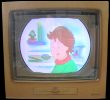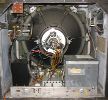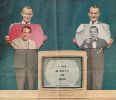
|
Vintage Television Sets and Colour Television Sets from the Dawn of Television until Now
Echard Etzold's Site |
 |
Early Color Television
Documentation: RCA Color TV Set 21-CT-7855U
"The Aldrich", Chassis CTE-5E
1956
Click photo to supersize it!
![[Text in deutsch]](Images/flag_de.jpg)
|

|

 When color TV was introduced in the U.S.A. in 1954 by RCA (with their CT-100), people were very skeptical. There were only a few hours of color programs broadcast weekly, the early picture tubes were only 15" and were too small to enjoy viewing, plus the sets were very expensive (originally more than $1,000 which is appr. 12,000 EUR today). Too expensive for the general public, and RCA lost money on every set sold in these days. But business must go on, so RCA decided to develop a cheaper set with a 21 inch screen. This was the "Aldrich" model, a simply designed set. The Aldrich was offered in fall of 1956 and was the first American color TV with a price of under $500. The set was advertised as so simple that "even a child can tune it" to counter the impression that color TV is much more complicated in adjusting a B&W TV (which of course it was). In another ad they claimed it was "Two sets in one" referring to B&W compatible color system created first by RCA.
This set's original owner was the broadcast engineer of CBC Toronto. As the story goes, the set was brought over to Canada from the U.S. in 1956 for CBC to use to conduct color broadcast testing as there was no available color sets in Canada. The set was converted to run on 25 cycle current by the engineering team at CBC to allow it to be hooked up to Canadian mains. He owned the set until 1994.
Beside VHF it has already a UHF tuner.
Certainly, the Aldrich is a table top model, but it has the size of a refrigerator and weighs approx. 100 kgs. When color TV was introduced in the U.S.A. in 1954 by RCA (with their CT-100), people were very skeptical. There were only a few hours of color programs broadcast weekly, the early picture tubes were only 15" and were too small to enjoy viewing, plus the sets were very expensive (originally more than $1,000 which is appr. 12,000 EUR today). Too expensive for the general public, and RCA lost money on every set sold in these days. But business must go on, so RCA decided to develop a cheaper set with a 21 inch screen. This was the "Aldrich" model, a simply designed set. The Aldrich was offered in fall of 1956 and was the first American color TV with a price of under $500. The set was advertised as so simple that "even a child can tune it" to counter the impression that color TV is much more complicated in adjusting a B&W TV (which of course it was). In another ad they claimed it was "Two sets in one" referring to B&W compatible color system created first by RCA.
This set's original owner was the broadcast engineer of CBC Toronto. As the story goes, the set was brought over to Canada from the U.S. in 1956 for CBC to use to conduct color broadcast testing as there was no available color sets in Canada. The set was converted to run on 25 cycle current by the engineering team at CBC to allow it to be hooked up to Canadian mains. He owned the set until 1994.
Beside VHF it has already a UHF tuner.
Certainly, the Aldrich is a table top model, but it has the size of a refrigerator and weighs approx. 100 kgs.
|


For German eyes, very unusual is the round screen which was common in the U.S.A. until the mid 1960s. Round screens were easier to build and they used a bezel to trim the viewable upper and lower part of the screen. This creates a partially rectangular screen with rounded corners on the sides. The wide gamut phosphors of the 21AXP22A requires a high beam current to generate sufficient brightness and contrast. The red phosphor is extremely weak and needs twice as much current as the green or blue in order to generate a clean white image. Very unusual is the very thick neck of the picture tube with approx. 5 cm. diameter. This is a lot more than the German 90آ "thick-neck tubes" which are known for their high deflection currents.
|


The picture tube is a 70آ deflection shadow mask tricolor Kinescope with a metal cone body. Only the screen face and the neck (which contained the three electron guns) were glass. Anode voltage is approx. 19 to 21 KV. The metal cone carries the full high voltage, therefore a plastic shield is installed around the cone to prevent arcing. On the outside of the plastic shield is a graphite cover which is connected to the chassis ground, and in effect operates as a high voltage capacitor. This picture tube here has still its original
date stamp of Sept. 12th, 1956.
|


On the left side one can see the power transformer. This is only for the tube heater voltage (6.3 volts with 12 amps). Outside the set on an extra board is another transformer for the anode currents with 400 volts output. Note that the Americans have a 115 voltage AC power line. In Germany we generate anode voltage directly by rectifying and voltage duplication of the 230 volts AC from the power line. For the lower power line voltage the Americans need big transformers in their sets. Behind the transformer are two rectifier tubes (5U4), the D.C. output is approx. 385 volts. The CTC-5 has 28 tubes and its power consumption is max. 350 watts. The high voltage for the Kinescope is generated by the flyback impulse of the horizontal output unit. A shunt regulator (6BK4) stabilizes the high voltage output and saves the picture tube by preventing arcs and an overheated shadow mask. The different units of the set are described in this photo. This chassis is partly recapped. It is equipped with printed circuits. The electronic components are inserted far apart (compared to German sets) from each other to prevent damage under difficult climatic conditions (high heat and humidity) like they have in the United States.
|


A view under the chassis reveals a very clean impression. Not all the printed circuits are visible. The IF and Chroma units are enclosed by metal shields. On the upper side of the chassis are the control adjustments for contrast, color, hue, vertical and horizontal hold. A little bit behind them are the controls for screen, static and dynamic convergence. Convergence units and controls for the 70آ defection tube are very simple in comparison to the extended convergence units of a 90آ or 110آ delta shadow mask color set.
|


On the left side one can see the chroma unit. It is realised in color difference concept. The R-Y, G-Y and B-Y signals were generated here
and added to the video or Y-signal in the Kinescope. For chroma output two 12AT7's were used. This unit needs recapping. The Unit on the left photo contain the chroma-IF, chroma carrier and 3.58 Mc oscillator.
|


The horizontal output unit has a power consumption of approx. 70 to 80 watts. Horizontal output current is approx. 208 ma (with 380 volts d.c.). The flyback transformer is got very warm after a one hour run of the set. It is insulated with wax, which melted and dropped to the bottom. I have re-insulated the flyback transformer with "Pastik 70" a kind of flowing plastic. In the future I wish to install a fan under the flyback transformer to cool it to extend the life of the transformer.
On the right side one can see the working set with the German color presentation logo of the years 1967 to 1970 which was broadcast before every color broadcast.
|


Again and again I read in old books that the early Kinescope picture tubes have low brightness so you have to wait until evening or you have to dim the room to watch TV. In a German book on the development of color television "Farbfernsehen - ein Geschenk unseres Jahrhunderts" by Walter Haas, (Color Television - a Gift of Our Century, written in 1967) there is a passage about a German foreign journalist in New York who had trouble with his color tv receiver ... "It lasts a long time until the licensed t.v. serviceman arrived. 'You need a transformer' he said, while he fetched a beer from the refrigerator. 'Remember the poor people', he added, 'which bought a color tv set in 1956. They have to sit in dark rooms. When lovers switch off the lights at that time they want to see color tv..."
I think the old TV sets are made worse than they really are. With a good fresh picture tube and well adjusted circuits viewing in with daylight is possible. Here is a comparison with a 1968 PAL hybrid set with a strong Permachrom tube (A66-120X): 1, 2,
3, 4. Remember, this 21APX22A is nearly 50 years old. The minor sharpness and color fringing on the CTC-5 depends on artifacts while converting the PAL signal to NTSC. But to avoid a wrong impression: I have a robust NTSC signal source without any drift in the color carrier. The contrast range of the PAL Y-signal is larger than in NTSC, therefore I get a contrast-richer picture here than in the U.S. My PAL to NTSC converter is a 30-EUR a cheap one from the U.K., which only converts the color carrier frequency and lowers the video response down to 3 Mc. Color programs in the 1950's weren't as natural as today's. Fleshtones aren't reliable enough because of color deficits of the cameras, and TV repairmen hadn't the experience in adjusting a set like those in the 1960's or 1970's.
|


What I'd like to show is that the possibility of true living color reproduction was almost possible in the 1950's. Especially with wide gamut phosphors
the color reproduction was so excellent that it could never realized in the later times until today. Some more screenshots 1, 2,
3, 4 and a photo of some CTC-5 models in der RCA exhibition hall in the 40 West 49th Street, Radio City, New York, 1956.
|
Schematics
Click here to see a pdf file for the CTC-5A deluxe chassis.
Tubes
6AF4, 6BQ7A, 6X8, 2mal 6DE6, 6CB6, 6AW8, 12BY7A, 6AU6, 6T8, 6AQ5, 6U8, 2mal 6CG7, 6AQ5, 6CB5A, 6AU4GTA,
1V2, 3A3, 6BK4, 6AW8, 2mal 12AT7, 6CB6, 6AN6, 2mal 5U4GB, 21AXP22A.
Photos: © Eckhard Etzold 2005
Links:
>
The First Eight Years of RCA Victor Color Receivers
Steve's Vintage Color TV page
VideoKarma.org Discussion Forums: Early Color Television

![[Zurück]](Images/arr-supr.jpg)
![[Text in deutsch]](Images/flag_de.jpg)
Stand: 24. Februar 2005,
|




















